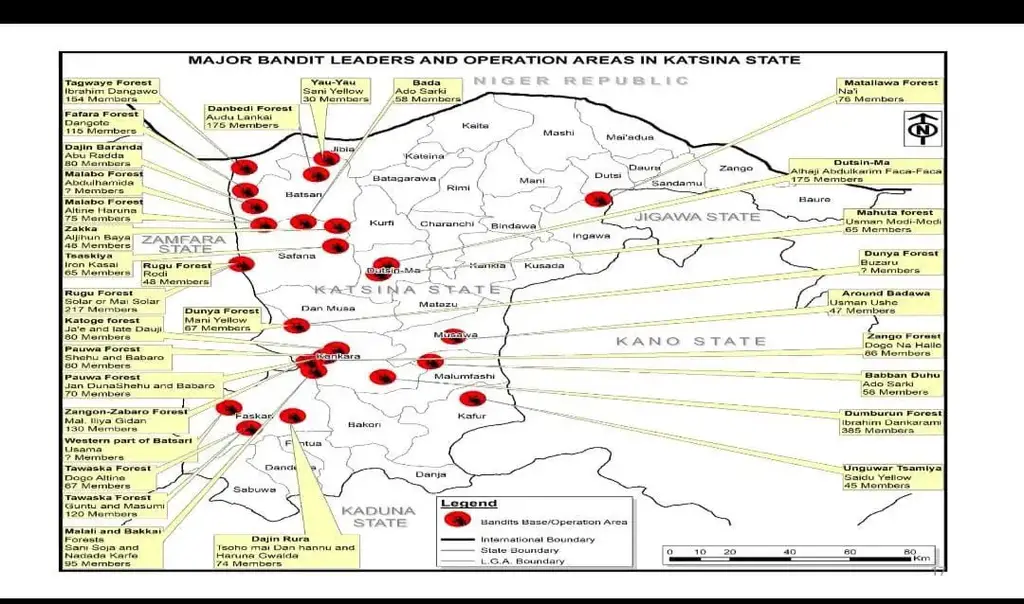UN report reveals 24 terror cells in Katsina, names leaders

A United Nations special report on the persistent insecurity situation in parts of Katsina State has unveiled 24 terrorists’ cells spread across about 30 forests in this North-West area of Nigeria. The report tagged, “Mapping the potentials of Transitional Justice in Katsina State,” also identified each terrorist leader by name as well as the numerical strength of each of the cells.
The UN International Organisation for Migration (IOM) and Mercy Corps carried out the research between September and October 2023, in collaboration with the Centre for Democracy and Development (CDD).
Funded by the European Union, the CDD presented the report last week in Katsina at a two-day “Capacity-building training programme for journalists to promote Participatory Transitional Justice System (TJS).”
Professor Suleiman Kura of Usman Dan Fodio University Sokoto, who coordinated the research project, explained that Research Assistants for the work were drawn from their respective Local Government Areas (LGAs), “due to the sensitive nature of the study and in view of the conflicts in the areas.”
For several years, states in the North-West zone of the country have become synonymous with banditry and the Federal Government designated the hoodlums as terrorists. The mode of operation of the terrorists is also as legendary, as they are known to invade communities, kill and maim innocent residents, burn their houses, rustle their cattle and in most reported cases abduct a number of residents for ransom.
Katsina has had perhaps more than its fair dose of the atrocities and brigandage more so with at least 23 out of the 34 LGAs wearing the tag of “frontline” as they are infested with marauding terrorists, according to the state government.
The 24 terrorists’ cells identified by the UN report are clustered within the forests some of which host multiple independent groups. In all, Katsina is home to some 2,295 terrorists even as the report does not specify the number of bandits in some of the cells. Each group is known to operate independently and a number of police reports often quote residents as estimating the number of bandits to be in excess of 200, “all riding on motorbikes” during each attack.
However, the report shows that Damburun forest camp alone located in Kankara Local Government Area has a population of 385 terrorists. Two separate camps identified by the report, located at the Rugu forest of Safana Local Government Area have a combined population of 265 of the hoodlums. The report further gives the figure of 175 bandits in the Dutsinma forest, a location that shares boundaries with Federal University Dutsinma.
According to the report, Batsari Local Government alone has a total of six forests housing eight separate gangs with a total population of 695 terrorists. The report does not indicate the population of bandits in one of the forests identified as “western part of Batsari” and the number of bandits too is not known for bandits in the Matazu forest and the Dunya forest but the report was able to identify their leaders.
Musawa, Malumfashi and Kafur Local Government Areas all share boundaries with Kano State and they have a combined population of 490 bandits in their separate forests.
Jibiya Local Government Area which shares international borders with Niger Republic is also home to the Yau-Yau forest with its 30 bandits, Danbedi forest with 175-member strong bandits gang in its Matalawa forest shares boundaries with Jigawa State.
The report affirms that the banditry menace started in Katsina State way back in 2010, in seven Local Government Areas, six of them have common boundaries with Zamfara State. According to the report, “initially, incidents of banditry were low with minimal causally figures” but the situation has taken monumental dimensions in recent years especially with the reported massacre of some 200 residents across three communities in Katsina in 2015 as well as the ambitious abduction of over 300 children in a single attack at a school in Kankara on December 11,2020. As at 2022, according to an IOM report, the total number of displaced persons from parts of the North-West peaked at 566,459 with 39 per cent of the figure from Katsina alone. The report confirmed that virtually everywhere in Katsina as in its neighbouring Zamfara, Sokoto and Kaduna states have been ravaged by banditry characteristic of rural terror of destruction of farmlands, killings, kidnappings, stealing of farm produce and rape, among various other forms of abuse. “This has been going on for more than a decade despite series of interventions of security agencies and government’s ostentatious amnesty initiatives.”
Still, the problem remains apparently intractable to the point that the immediate past Governor Aminu Bello Masari tagged the bandits “animals” and directed residents to procure arms and defend themselves. Again, banditry persists in Katsina even with more effrontery as the daredevil terrorists have since developed an appetite for occasional incursions into the townships and Local Government Areas headquarters. Late last year, they raided an off-campus hostel and reportedly abducted five female students of the university there.
The current administration of Governor Dikko Radda has since launched its brand of checking the menace of banditry with the establishment of the Community Watch Corps, to complement efforts of the regular security operatives. Only time will tell if this development will eventually achieve the desired outcome.
But with the locations of the bandits’ cells identified and their leaders known, what does it take for the relevant security agencies to smoke them out of the forests? According to the Coordinator of the UN report, “sincerely speaking, this is one question that I am not in a position to provide an answer.”
Culled from TheSun

